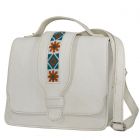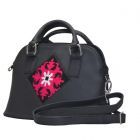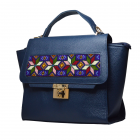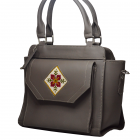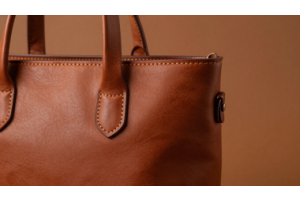Spotting Real vs. Fake Leather: A Shopper’s Guide to Quality

Spotting Real vs. Fake Leather: A Shopper’s Guide to Quality
When it comes to buying leather goods, knowing how to spot genuine leather can save you from costly mistakes. Real leather has a natural grain pattern, a rich earthy scent, and develops a unique patina over time—something synthetic leather can’t replicate. Run your fingers across it; authentic leather feels soft yet sturdy, with slight imperfections that highlight its authenticity. In contrast, fake leather often looks too perfect, feels plastic-like, and has an artificial shine. Always check the edges, smell, and flexibility of the material before buying. Investing in real leather means choosing durability, character, and timeless style that only improves with age.
Table Of Content
- 1. Introduction – Why Leather Quality Matters
- 2. Understanding the Types of Leather
- 3. Key Signs of Real Leather
- 4. Common Traits of Fake Leather
- 5. Quick Tips to Identify Genuine Leather While Shopping
- 6. Why Investing in Real Leather Is Worth It
- 7. Caring for Your Leather Goods
- 8. Conclusion – Buy Smart, Buy Authentic
- FAQs
1. Introduction – Why Leather Quality Matters
Leather quality goes far beyond appearance — it defines how long your item will last, how it feels in your hands, and how it ages over time. High-quality leather is made from carefully selected hides that are tanned using natural or vegetable-based methods, ensuring durability, breathability, and a soft, natural texture. Unlike synthetic or low-grade leather, it develops a rich patina with use, adding character and depth to the piece. Cheap or fake leather, on the other hand, tends to crack, peel, and lose its shape quickly.
Choosing quality leather means investing in longevity, sustainability, and timeless style. A well-made leather product doesn’t just look better — it tells a story, ages beautifully, and often lasts for decades with proper care.
Quick Tip:
Always check the texture and smell — real leather feels soft, slightly uneven, and has a rich, natural scent, while fake leather feels plastic-like and smells synthetic.
Visit HimalayanBits and explore our exclusive collection—you’ll see the difference in craftsmanship and style.
2. Understanding the Types of Leather
Not all leather is created equal — the type of leather determines its quality, texture, and lifespan. Knowing these variations helps you make smarter choices when buying leather goods. Here’s a quick breakdown of the most common types:
- Full-Grain Leather: The highest-quality leather from the top layer of the hide. Retains natural marks and develops a rich patina over time.
- Top-Grain Leather: Slightly sanded and refinished for a smoother, more uniform look. Durable and more stain-resistant than full-grain, but a bit less characterful.
- Genuine Leather: Made from lower layers of the hide. More affordable but thinner and less durable than top- or full-grain options.
- Bonded Leather: Manufactured from leather scraps bound with adhesives and synthetics. Looks like leather at first glance but wears poorly and can peel.
3. Key Signs of Real Leather
Genuine leather has distinct characteristics that set it apart from synthetic or faux materials. Paying attention to these small details can help you confidently identify real leather while shopping.
- Texture and Feel: Real leather feels soft, flexible, and slightly uneven, with natural grain patterns. It should not feel overly smooth or plastic-like.
- Smell: Authentic leather has a rich, earthy scent that’s hard to imitate. Fake leather often smells like chemicals or plastic.
- Appearance: Real leather shows minor imperfections and variations in color — a sign of authenticity, not a flaw.
- Water Absorption: A small drop of water should be absorbed slowly by real leather, while fake leather repels it instantly.
- Flexibility: When bent or stretched, genuine leather wrinkles slightly and returns to shape easily, unlike fake leather which stays stiff or cracks.
4. Common Traits of Fake Leather
Fake or synthetic leather may look appealing at first, but it lacks the natural qualities, durability, and charm of genuine leather. Understanding these key differences will help you avoid poor-quality imitations and make smarter purchases.
| Trait | Description |
|---|---|
| Surface Texture | Usually too smooth or uniform, lacking the natural grain patterns found in real leather. |
| Smell | Has a chemical or plastic-like odor instead of the rich, earthy scent of genuine leather. |
| Flexibility | Feels stiff or overly stretchy. It doesn’t wrinkle naturally when bent. |
| Appearance Over Time | Tends to peel, crack, or fade quickly with regular use, unlike real leather which develops a patina. |
| Edges | Often have a shiny, plastic finish, while real leather edges appear rough and fibrous. |
5. Quick Tips to Identify Genuine Leather While Shopping
When browsing for leather goods, small tests and visual cues can help you tell the difference between real and fake leather. Use these quick tips to make confident, informed choices before you buy.
- Check the Label: Look for terms like “Full-Grain” or “Top-Grain.” Avoid items labeled as “PU” or “synthetic leather.”
- Touch and Feel: Real leather feels warm, soft, and flexible, while fake leather feels cold, smooth, and plastic-like.
- Smell the Material: Authentic leather has a natural, earthy scent — fake leather smells chemical or artificial.
- Inspect the Edges: Real leather has rough, fibrous edges; fake leather edges appear shiny and perfect.
- Perform a Water Test: Drop a small amount of water on the surface — genuine leather absorbs it slowly; fake leather repels it.
- Check the Price: If it seems too cheap for a “leather” product, it’s probably not real leather.
6. Why Investing in Real Leather Is Worth It
Choosing real leather isn’t just about luxury — it’s about long-term value and sustainability. High-quality leather goods are built to last for years, often improving in appearance with time. Unlike synthetic materials that wear out or peel, genuine leather grows softer, develops a rich patina, and becomes more comfortable the longer you use it.
Real leather also offers better breathability, natural strength, and resistance to tearing, making it ideal for everyday use. While it may cost more upfront, it saves you money in the long run by eliminating frequent replacements. Additionally, genuine leather is biodegradable and made through more eco-conscious methods compared to synthetic alternatives, which rely on plastics and chemicals.
7. Caring for Your Leather Goods
Proper care keeps your leather looking elegant and ensures it lasts for years. Leather is a natural material that responds well to gentle maintenance and the right storage. Follow these essential care tips to preserve its beauty and strength.
| Care Step | Description |
|---|---|
| 1. Regular Cleaning | Wipe your leather goods with a soft, dry, or slightly damp cloth to remove dust and dirt. Avoid harsh chemicals or detergents. |
| 2. Conditioning | Apply a quality leather conditioner every few months to keep the leather soft, moisturized, and crack-free. |
| 3. Protection from Water | Use a leather protector spray to prevent water damage. If leather gets wet, dry it naturally — never use heat. |
| 4. Proper Storage | Store leather items in a cool, dry place. Use a dust bag and avoid plastic covers that trap moisture. |
| 5. Avoid Direct Sunlight | Prolonged exposure to sunlight can fade and dry out the leather. Keep it away from strong light sources when not in use. |
8. Conclusion – Buy Smart, Buy Authentic
Knowing how to spot real leather and understanding its qualities ensures that you invest in products that last, look better over time, and offer unmatched comfort and style. Genuine leather stands out for its texture, scent, flexibility, and durability — features that fake leather simply cannot replicate.
By paying attention to labels, texture, smell, and craftsmanship, you can make smarter purchases and avoid low-quality imitations. Investing in authentic leather is not just about luxury; it’s about sustainability, value, and timeless elegance. Choose quality, care for it properly, and enjoy leather goods that age beautifully with you.
9. FAQs
1. How can I tell if leather is real at first glance?
Look for natural grain patterns, minor imperfections, and a soft, flexible feel. Real leather has a rich, earthy scent, unlike synthetic materials.
2. What’s the difference between full-grain and top-grain leather?
Full-grain leather comes from the top layer of the hide and retains natural markings. Top-grain is sanded and treated for smoothness but is slightly less durable.
3. Is bonded leather considered real leather?
Bonded leather contains leather scraps mixed with synthetics. It looks like leather but lacks the durability, texture, and natural aging of genuine leather.
4. Can I use a water test to check leather authenticity?
Yes. Real leather absorbs a small drop of water slowly, while fake leather repels it instantly.
5. Why does real leather smell different from fake leather?
Authentic leather has a natural, earthy aroma from the tanning process, whereas fake leather often smells like plastic or chemicals.
6. How does leather age over time?
Genuine leather develops a patina — a unique sheen and softness — enhancing its character. Fake leather cracks, peels, or fades instead.
7. Is high price always an indicator of real leather?
Not always. While quality leather costs more, some high-priced items may still use synthetic materials. Always check texture, smell, and labels.
8. How should I store leather products to keep them in good condition?
Store in a cool, dry place, away from direct sunlight. Use dust bags and avoid plastic covers to prevent moisture buildup.
9. Can I clean leather with water?
Use a slightly damp cloth for cleaning. Avoid soaking leather or using harsh detergents, which can damage the material.
10. Why is investing in real leather worth it?
Real leather is durable, ages beautifully, and offers long-term value. With proper care, it can last decades and provide a timeless style that synthetic materials cannot match.

